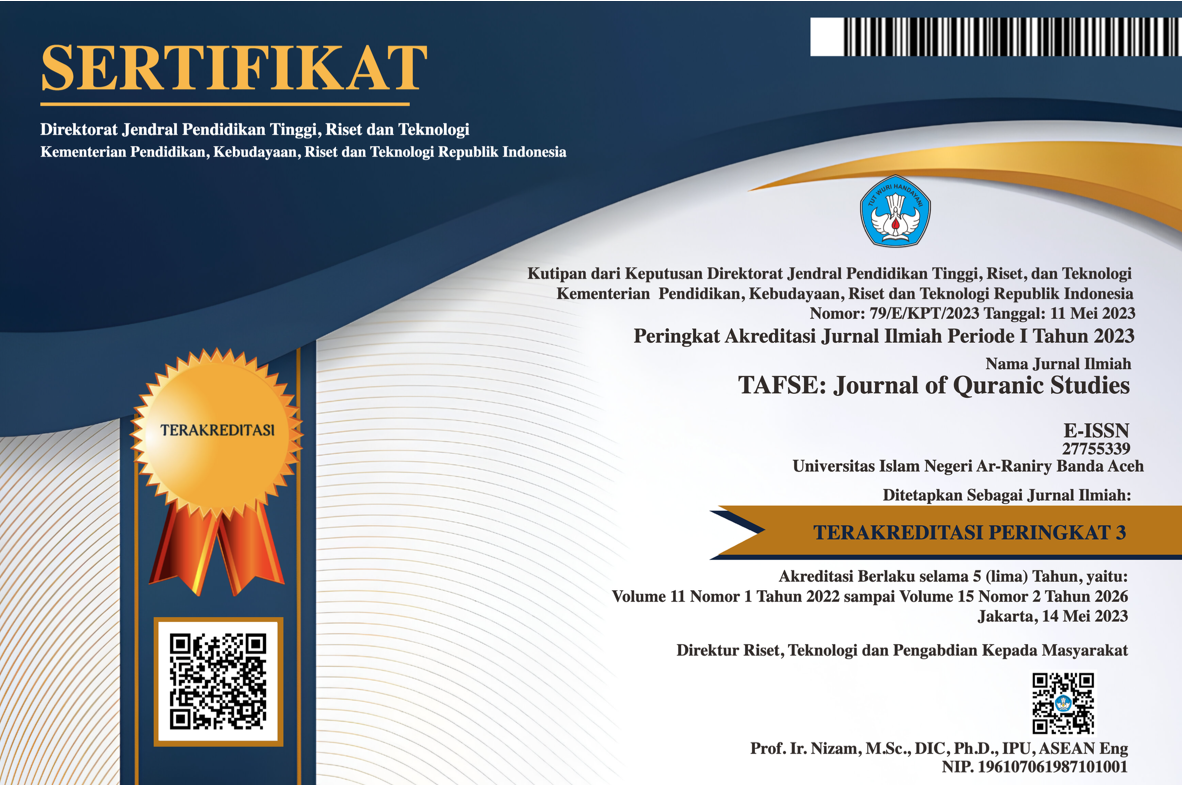Interpretasi Perintah Sujud pada Kisah Nabi Adam menurut Para Mufasir
DOI:
https://doi.org/10.22373/tafse.v6i2.10185Keywords:
Perintah Sujud, Nabi Adam, Al-Qur’anAbstract
Prostration is proof of the closeness between beings to Allah Swt as their God, by placing his head on the ground as worship that is only done to Allah. This is different from the story of Prophet Adam, and God commanded the angels and demons to prostrate to Prophet Adam. This article attempts to discuss the meaning of prostration in the story of the Prophet Adam. The research method used is the method of maudhu'i which is the method of interpreting the verses of the Qur'an thematically. The type of research that the author uses is the type of literature research, by collecting data following the topic of discussion. The analysis technique that the author uses is descriptive analysis; that is, the author tries to understand the verses based on the interpretation of the scholars and also based on other sources. According to the commentators, this article discusses the command of prostration in the story of the Prophet Adam. The result of the research is the description of prostration in the story of the Prophet Adam in the Qur'an, which is included in various surahs such as surah al-Baqarah, al-Hijr, al-A’raf, al-Isra, al-Kahfi, Thaha, and surah Shad. There are also differences of opinion among scholars in interpreting the verses in which it explains the story of the command of prostration to the Prophet Adam.
Sujud merupakan bukti ketaatan dan kedekatan makhluk dengan Allah Swt sebagai Tuhan. Sujud dilakukan dengan merendahkan diri, menundukkan badan dan meletakkan kepala di bawah sebagai bentuk penyembahan. Dalam pengertian tersebut, tidak ada sujud yang boleh dilakukan oleh makhluk selain kepada Allah. Namun di sisi lain, Allah Swt memerintahkan para malaikat dan iblis untuk sujud kepada Nabi Adam. Tulisan ini bertujuan untuk mengetahui makna sujud pada kisah Nabi Adam. Penelitian kepustakaan ini dilakukan dengan menggunakan metode maudhu’i untuk menemukan ayat-ayat yang terkait dengan tema yang dimaksud. Kemudian dianalisa secara deskriptif dengan memahami ayat-ayat melalui penafsiran para ulama dan sumber-sumber lain. Hasil penelitian menunjukkan bahwa deskripsi sujud pada kisah Nabi Adam dalam al-Qur’an terangkum dalam berbagai surah, yaitu QS. al-Baqarah, QS. al-Hijr, QS. al-A’raf, QS. al-Isra’, QS. al-Kahfi, QS. Thaha, dan QS. Shad. Dari ayat-ayat tersebut, diketahui bahwa Allah Swt memerintahkan para malaikat dan iblis untuk sujud kepada Nabi Adam sebagai bentuk penghormatan, bukan sebagai penyembahan.
Downloads
References
Al-Ashfahani. Mu’jam Mufradat Alfazh Al-Qur’an. Beirut: Dar al-Fikr, 1990.
Al-Dimasyqi, Al-Imam Abu al-Fida Isma’il Ibnu Kasir. Tafsir Ibnu Katsir, Jilid 1. Bandung: Penerbit Sinar Baru Algensindo, 2012.
Al-Maraghi., Aẖmad Mustafa. Tafsir Al-Maraghi, Jilid 23. Semarang: PT. Karya Toha Putra, 1974.
Aman, Saifuddin. Mengungkap Keajaiban Sujud. Jakarta Selatan: al-Mawardi Prima, 2009.
Anwar, Rosihon. Ilmu Tafsir. Bandung: Pustaka Setia, 2005.
Azizah, Nur. “Interpretasi Mufassir Terhadap Tikrar Kisah Nabi Adam Dalam Al-Qur’an.” Universitas Islam Negeri Sunan Ampel Surabaya, 2019.
Farihin, Hibbi. “Semua Ilmu Ada Dalam Al-Qur’an: Telaah Pemikiran Al-Suyuthiy Dalam Al-Itqan Fi ‘Ulum Al-Qur’An.” Ilmu-Ilmu Ushuluddin, no. 1 (2016): 1.
Hakim, Baqir. “Kisah Nabi Adam Dalam Penafsiran Baqir Hakim (Universitas Islam Negeri Sunan Kalijaga Yogyakarta).” Universitas Islam Negeri Sunan Kalijaga Yogyakarta, 2008.
Ilyas, Dedy. “Di Balik Kisah Nabi Adam: Menarik Nalar Makna Penciptaan.” Ilmu Agama UIN Raden Fatah, 2014.
Mutholib, Umar Fauzi. “Wawasan Al-Qur’an Tentang Respon Iblis Terhadap Perintah Sujud (Sebuah Pendekatan Teologis Dan Sufistik).” Al-Ashriyyah: Journal of Quran and Hadits Studies 6, no. 2 (2020).
Penyusun, Tim. Kamus Bahasa Indonesia. Jakarta: Pusat Bahasa Departemen Pendidikan Nasional, 2008.
Qutub, Sayyid. Tafsir Fi Zhilal Al-Qur’an, Jilid 1. Jakarta: Gema Insani, 2000.
Shihab, M.Quraish. Tafsir Al-Mishbah, Kesan Dan Keserasian Al-Qur’an. Jakarta: Lentera Hati, 2000.
T. Muhammad Hasbi ash-Shiddieqy. Tafsir Al-Qur’anul Majid an-Nuur, Jilid 1. Semarang: Pustaka Rizki Putra, 2000.
Thadi, Robeet. “Komunikasi Transentral: Shalat Sebagai Bentuk Komunikasi Transendent.” Jurnal Ilmiah Syi’ar, 2017, 51.
Wahidah, Satia Baktiyani. “Dimensi Ekonomi Dalam Kehidupan Nabi Adam (Tafsir Surah Thaha Ayat 117-119 Dan Surah Al-Baqarah Ayat 36).” Eksisbank, no. 2 (2018): 32.
Yunan, Ummi Suhaila binti Muhammad. “Keragaman Makna Lafaz Baghyu Dalam Al-Qur’an.” Universitas Islam Negeri Ar-Raniry Banda Aceh, 2019.
Zahro’unnafi’ah, Kunti Nur Alfiatus. “Konsep Humanisme Dalam Tafsir Surah Al-Baqarah Ayat 30-39 Dan Relavansinya Terhadap Tujuan Pendidikan Islam (Kajian Tafsir Al-Mishbah Karya M. Quraish Shihab).” Institut Agama Islam Negeri Ponogoro, 2018.
Downloads
Published
Issue
Section
License
Authors who publish with this journal agree to the following terms:
- Authors retain copyright and grant the journal right of first publication with the work simultaneously licensed under a Creative Commons Attribution License (CC BY NC 4.0) that allows others to share the work with an acknowledgment of the work's authorship and initial publication in this journal.
- Authors are able to enter into separate, additional contractual arrangements for the non-exclusive distribution of the journal's published version of the work (e.g., post it to an institutional repository or publish it in a book), with an acknowledgment of its initial publication in this journal.
- Authors are permitted and encouraged to post their work online (e.g., in institutional repositories or on their website) prior to and during the submission process, as it can lead to productive exchanges, as well as earlier and greater citation of published work (See The Effect of Open Access).





